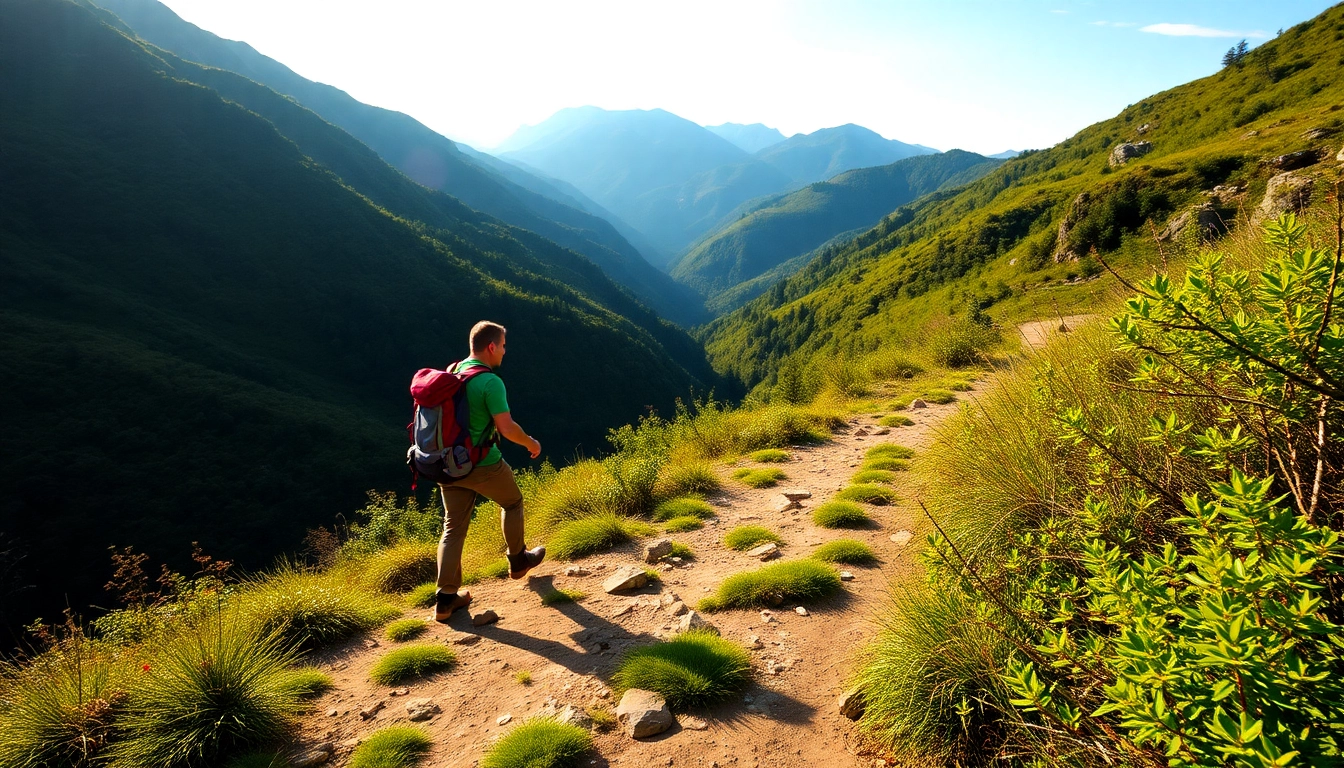Introduction to Hiking in Indonesia: Nature, Culture, and Benefits
Indonesia, an archipelago comprising over 17,000 islands, is renowned for its stunning landscapes, diverse ecosystems, and rich cultural heritage. Among its many outdoor activities, hiking stands out as a premier way to explore the country’s scenic beauty and connect with nature intimately. Whether traversing lush tropical rainforests, climbing volcanic peaks, or wandering through traditional villages, hiking in Indonesia offers an unparalleled experience for adventure enthusiasts and nature lovers alike. This activity not only provides physical and mental health benefits but also promotes cultural understanding and environmental conservation.
What Makes Indonesia a Unique Hiking Destination?
Indonesia’s unique geographical and ecological features make it a compelling destination for hikers. The country is home to some of the world’s most active volcanoes, vast mountain ranges, pristine beaches, and dense forests. For example, Mount Rinjani in Lombok, an active volcano and the second highest in Indonesia, attracts thousands of hikers annually eager to summit its crater and enjoy panoramic views.
Additionally, Indonesia’s biodiversity is extraordinary. The islands host diverse flora and fauna, some of which are endemic. The Taman Nasional Gunung Leuser and Ujung Kulon National Park are UNESCO World Heritage Sites teeming with rare species like orangutans and Javan rhinos, offering hikers the chance to witness wildlife in its natural habitat.
The cultural richness adds layers to hiking excursions. Incorporating visits to local villages, temples, and markets enables hikers to immerse themselves in traditional Indonesian cultures while engaging in outdoor activities. This blend of natural splendor and cultural vibrancy makes Indonesia a unique hiking destination on a global scale.
Health and Mental Wellness Benefits of Hiking
Engaging in regular hiking confers a myriad of health advantages. Physically, it promotes cardiovascular health, strengthens muscles, improves joint mobility, and enhances endurance. A study published by the American Heart Association indicates that outdoor physical activities like hiking can reduce the risk of heart disease and obesity.
Mentally, hiking offers significant emotional and psychological benefits. The exposure to nature has been linked to stress reduction, improved mood, and increased mental clarity. Nature’s calming effects can alleviate symptoms of anxiety and depression, promoting a sense of well-being. For instance, hiking in tranquil environments such as Bali’s rice terraces or the forested slopes of Java can foster mindfulness and mental rejuvenation.
Furthermore, outdoor exercise stimulates vitamin D production from sunlight exposure, essential for bone health and immune function. The combination of physical activity, fresh air, and scenic vistas creates a holistic approach to wellness that is both accessible and sustainable.
Case Study: Mental Health Impact of Hiking in Indonesian Jungles
A longitudinal study conducted among local populations and tourists in Indonesian national parks revealed a marked decrease in stress and improvement in overall mood after hiking expeditions. Participants reported increased feelings of happiness, clarity, and connection with nature, reinforcing the mental health benefits of outdoor activities.
Preparing for a Hiking Trip in Indonesia’s Diverse Terrain
Preparation is crucial for a successful and enjoyable hiking experience, especially given Indonesia’s varied terrain and climate conditions. Proper planning ensures safety, comfort, and the ability to handle unexpected challenges effectively.
Understanding the Terrain and Climate
Indonesia’s terrain ranges from volcanic mountains, steep valleys, and dense rainforests to coastal paths and rice paddies. Altitude varies significantly, with some peaks reaching over 3,700 meters. The climatic conditions can be tropical, humid, and prone to sudden rain showers, making appropriate gear and timing essential.
Researching specific trails and local weather patterns helps in selecting suitable times for hiking—dry seasons typically from May to September are ideal for most regions. Storms and heavy rainfall can lead to slippery paths and increased risks, so timely planning is fundamental.
Health and Safety Precautions
Before embarking on a hike, consult with a healthcare provider, especially if you have underlying health conditions. Carry necessary medications, including antimalarials, and ensure vaccinations are up-to-date, particularly for rabies and hepatitis.
Hydration and nutrition are vital; bring sufficient water and energy-dense snacks. Also, familiarize yourself with basic first aid procedures and emergency contact numbers for local rescue services.
It’s advisable to hike with experienced guides, particularly when exploring remote or challenging terrains. Local guides possess invaluable knowledge of the trails, wildlife, and possible hazards, enhancing safety and enriching the experience.
Physical Preparation and Skill Building
Building stamina through regular aerobic exercise, such as walking or stair climbing, prepares the body for longer hikes. Strengthening leg muscles, core, and endurance improves overall hiking efficiency. Beginners should gradually increase their hike distances and difficulty to avoid injuries.
Acquiring basic navigation skills, understanding trail markers, and carrying a detailed map or GPS device can prevent getting lost. Practice setting up tents and basic camping skills if planning multi-day trips.
Planning Your Hiking Route: Trails, Tips, and Resources
Choosing the right trail and preparing thoroughly defines the quality of your hiking adventure. With numerous routes across Indonesia, careful planning aligns your skill level, interests, and time availability.
Popular Hiking Trails Across Indonesia
- Mount Rinjani (Lombok): A challenging trek to Indonesia’s second-highest volcano, offering spectacular crater lakes and hot springs.
- Mount Bromo (East Java): Known for its surreal volcanic landscape, sunrise views, and easy accessibility for beginners.
- Kelimutu Lakes (Flores): Famous for its three colorful crater lakes, accessible via moderate trails.
- Gunung Leuser National Park (Sumatra): A lush rainforest habitat, ideal for wildlife viewing and jungle trekking.
- Mount Semeru (Java): Indonesia’s highest mountain, demanding technical skills but rewarding with panoramic vistas.
Choosing the Right Trail for Your Skill Level
Beginners should start with well-marked and accessible routes like Mount Bromo or the Sekumpul Waterfall hiking trail in Bali. These hikes require moderate physical effort and are suitable for families and casual hikers.
Intermediate and experienced hikers can challenge themselves with multi-day treks like Rinjani or Semeru, which require physical endurance, proper planning, and technical skills. Advanced routes involve rugged terrains, altitude gains, and potentially challenging weather conditions.
Essential Resources and Apps for Hikers
Modern technology enhances safety and planning. Consider downloading apps like AllTrails, Gaia GPS, or Komoot. These tools offer detailed maps, trail descriptions, GPS navigation, and user reviews.
Local guides and tourism offices provide invaluable resources, including trail maps, current conditions, and safety advisories. Ensure to check weather forecasts and park regulations before your trip.
Gear and Equipment for Safe Hiking in Indonesia
Appropriate gear ensures comfort, safety, and preparedness for Indonesia’s varied environment. Investing in quality equipment reduces risks linked to weather, terrain, and unforeseen circumstances.
Must-Have Hiking Gear and Clothing
- Breathable, moisture-wicking clothing: Helps regulate body temperature and keeps you dry.
- Lightweight waterproof jacket: Essential for sudden rain showers.
- Hiking backpack: With compartments for gear, water, and snacks.
- Sun protection: Wide-brim hat, sunglasses, and high-SPF sunscreen.
- Insect repellent: Especially critical in rainforest zones.
Hiking Shoes: Selection and Maintenance
Choosing the right footwear is vital. Opt for sturdy, well-fitting hiking boots with good ankle support and slip-resistant soles. Leather or waterproof shoes are preferred in wet conditions.
Regular cleaning and waterproofing extend shoe lifespan. Inspect for damage and replace worn-out soles to prevent injuries.
Weather-Appropriate Equipment and Safety Tips
Be prepared for tropical weather with quick-drying clothes, thermal layers for cooler mountain regions, and leg gaiters to keep debris out. Carry sufficient water, a portable water filter or purification tablets, and a compact first aid kit.
Stay informed about weather forecasts, and avoid hiking during storms or heavy rainfall to minimize hazards such as landslides or slippery trails.
Common Challenges and How to Overcome Them
Hiking in Indonesia’s diverse terrains presents unique challenges. Recognizing these obstacles and preparing for them ensures safety and enjoyment.
Dealing with Terrain and Altitude
Steep ascents, uneven paths, and altitude sickness are common concerns. Pace yourself and ascend gradually to acclimate. Use trekking poles for stability and reduce fatigue. Recognize symptoms of altitude sickness, such as headaches or nausea, and descend if necessary.
Navigating Through Dense Forests and Mountainous Areas
Dense jungle trails may obscure landmarks. Always carry a GPS device and compass, and stick to established routes. Travel with experienced guides for better navigation and safety.
Additionally, be vigilant for wildlife encounters; maintain a safe distance and avoid provoking animals.
Safety Precautions and Emergency Preparedness
Inform someone about your itinerary and estimated return time. Carry an emergency communication device if possible. Establish a contingency plan for injuries or lost routes.
Learn basic survival skills like fire-starting, shelter construction, and first aid to handle unexpected situations confidently.
Maximizing Your Hiking Experience: Respect, Conservation, and Local Culture
Respectful and responsible hiking enriches the experience for you and preserves Indonesia’s natural and cultural treasures for future generations.
Practicing Responsible Hiking and Leave No Trace
- Carry out all trash and avoid disturbing wildlife.
- Stay on designated trails to prevent erosion and habitat damage.
- Respect plants, animals, and the environment—do not pick flowers or feed wildlife.
- Minimize campfire impacts and use eco-friendly products.
Adopting Leave No Trace principles helps in conserving Indonesia’s pristine landscapes and maintaining their beauty for others to enjoy.
Engaging with Local Communities Respectfully
Interact courteously with local residents, learn about their traditions, and support local economies by purchasing handcrafted souvenirs or hiring local guides. Respect cultural sites and follow community guidelines.
This genuine engagement fosters cultural exchange and promotes sustainable tourism.
Capturing Memories and Sharing Your Journey
Document your hikes through photos, videos, and journals. Share your experiences on social media responsibly, emphasizing conservation messages and local appreciation. Remember that leaving a positive impact and inspiring others is a valuable part of your journey.






